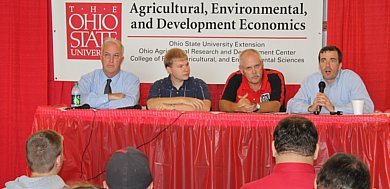Shale gas fuels first-day discussions at Ohio FSR
Tuesday, September 20, 2011

LONDON, Ohio — The potential for profit and regional economic gain in the Marcellus and Utica Shale industries has brought a lot of excitement to this year’s Ohio Farm Science Review, which began today and runs through Sept. 22.
At least three of the first major sessions at the review addressed the progress of drilling, mineral rights, and landowner options.
“The oil and gas business in Ohio is exploding,” said Mike Lloyd, OSU assistant professor in community development.
Lease offers continue to be made on a daily basis, and the volume of industrial equipment and workers moving into eastern Ohio and western Pa. is picking up, officials said.
“This is a once in a lifetime opportunity for philanthropy in a region of the state that’s never seen much philanthropy,” Lloyd said.
Much to consider
But the “explosion” of activity needs to be controlled, officials warned, to protect financial assets as well as environmental resources — as basic as land and water.
The drilling and fracking take a lot of water, usually 2.5-8 million gallons per well. The water used for fracking is contaminated in the process, but currently is being reused and recycled, said Allen Klaiber, OSU ag economics professor.
“There is an incredible amount of technology that’s working on (water quality)” and recycling, he said.
Another concern is the traffic created by the industry. When drilling begins, “the truck traffic is tremendous,” Klaiber said, often on the windy, narrow roads of eastern Ohio.
For local businesses like restaurants and hotels, increased traffic is good. Klaiber said some communities have discussed ways to re-route the traffic to improve traffic flow, but must be cautious of long-term effects, and whether new or improved routes might cause the traffic to bypass local businesses altogether.
Protecting water
The biggest concern on the minds of those at the review, and likely across the two-state region, is drinking water.
“If everything goes right there should be no problems,” Klaiber said.
Where problems have surfaced, it’s often with faulty casings (well linings), in which case the contaminated water or methane gasses can come in contact with the drinking water. The depth of 200-500 feet is where most local drinking water comes from, he said, and is the biggest area of concern.
Major drilling companies have begun to test water in this depth prior to drilling, officials said, so they can note and document any changes to local water supplies. Water tests can usually be done for $100 or less, and establish certainty over any changes to the quality during or after drilling.
Klaiber said the fee for testing is worth paying, because it establishes liability, should there be any issues.
“If there are problems down the road, you know where they came from,” he said.
Other issues
Several landowners who attended an afternoon session on natural gas called Question the Authorities said they were concerned about noise, water use and financial gains and losses.
Wishing to remain unnamed, one landowner said his advice to others is “to be patient.”
Officials said some of the earliest leases paid to landowners ranged from $20-$50 an acre. Now, it’s common to be offered $2,500-$5,000.
Peggy Hall, OSU’s director of ag law, said her advice to landowners is “not to sign anything when you get that first knock at the door. You have a resource, therefore you have time on your side.
Land groups
Some landowners have increased their bargaining power by joining land groups, essentially combining their acreage into a cooperative. That can bring many positives and a few negatives, Lloyd explained, depending on the people leading the group and what they know.
Hall and other officials continue to advise landowners to consult with knowledgeable attorneys who are experts in natural gas leases.
“It’s a very special area of law and it’s a very complex area of law,” she said.
Some existing leases may need to be reevaluated and in some cases legally challenged — especially those made prior to the exploration and drilling of shale gas. Hall said in some cases, if minerals under lease haven’t been touched for a period of 20 years or more, they may qualify for the “dormant mineral” policy, and be statutorily terminable.
OSU Extension can provide information and suggestions, officials said, but is not in the position to tell producers which groups to join, nor for what amounts to sign leases.
Many hands were raised during each of the sessions, with questions being asked and answered throughout the day.
“This is an industry that is moving very quickly,” said Douglas Southgate, an OSU ag economics professor.
As it moves, so do local economies. New jobs are being created — often in related industries like water quality improvement, hotels and restaurants. And the supply of natural gas is outpacing demand, he said, and price is dropping.




